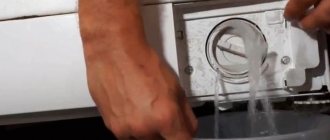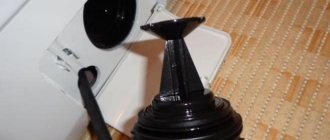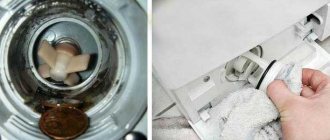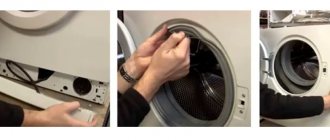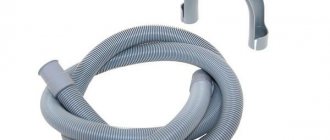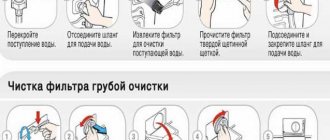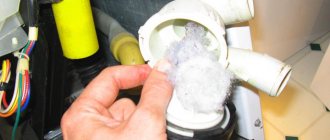When is cleaning necessary?
The filter needs to be cleaned as it gets dirty. Experts recommend performing this procedure for preventive purposes once every 2-3 months.
For Diamond series devices, you need to clean the filter at least 5-6 times a year. The more actively household appliances are used, the more often the procedure should be carried out .
Provided that an animal lives in the house, these deadlines are shifted. As practice shows, the filter needs to be cleaned after every 10-15 washing cycles.
If you ignore the advice, then one day the filter will clog. The machine will not be able to drain the water in the usual way and will have to carry out this procedure in emergency mode. In this case, the error code, 5C or will be displayed on the screen.
Error E2 is typical for those machines that were released before 2007 . Other codes appear on more modern models. Error 5E and E5 should not be confused. Code E5 indicates a malfunction in the water heating system, and not a clogged filter.
Not all Samsung washing machines are equipped with a screen. If it is not there, then a clogged filter will be indicated by a burning 40 degree indicator and flashing lights in all operating modes. If there is no error, but the part is clogged, the water after washing will drain more slowly than usual.
An unpleasant odor emanating from the washing machine may indicate that a blockage has formed. It becomes especially intense if the device is not used for several days.
Samsung washing machine drain filter: description
During operation, the water in the Samsung washing machine becomes dirty, and foreign objects also get into it: threads, hair, buttons, coins and others. They gradually accumulate, preventing the circulation and drainage of water. The filter purifies water by trapping contaminants and foreign objects.
Over time, it becomes clogged, slowing down the machine and reducing the quality of the wash. The rate at which debris settles depends not only on the operating time, but also on what items are washed.
The Samsung washing machine has two filters. One of them purifies the water supplied for washing (fill water). The other is designed to filter water during circulation inside the washer and when draining (drain filter). When the machine’s operation ends, all the water from the tank is drained, but a small amount of liquid remains in the filter and pipes. This must be kept in mind when removing the filter.
Signs you need cleaning
You can know that it is time for cleaning by the appearance of the following signs:
- The machine's diagnostic system detects the presence of unidentified faults.
- Draining is performed with less intensity than usual.
- The work is blocked for an unknown reason.
- Regular failures occur during rinsing.
- When spinning occurs, the operation stops. However, the reason for the shutdown cannot be determined.
- Washed laundry develops an unpleasant odor.
If there was a situation in which one or more symptoms from the list above occurred, then it is necessary to monitor the condition of the drain filter and, if necessary, clean it.
Types of blockages
Blockages can be divided into two types:
- Mechanical include the ingress of foreign objects. Often clothes are put into the wash with small items left in their pockets. Sometimes buttons and decorative items are used that easily come off and end up in the drain.
- This category also includes lint, hair, and pet hair.
It is impossible to completely stop filter contamination, however, by following simple rules, you can significantly reduce its speed.
Design features and location
The main part of the filter is a mesh, which is secured in a plastic mounting structure. The filter screws into the hole, which is located on the lower right side of the front panel of the washing machine. To see it you need to remove the protective panel.
Filtration principle
During draining or circulation, water is passed through a drain filter mesh. At the same time, small objects linger on it and impede the passage of water.
After finishing the wash, the accumulated dirt remains in place. Thus, filter contamination increases over time.
If you do not clean it in time, the water will pass through the mesh more and more slowly. This can cause increased equipment wear and malfunctions. To avoid this, it is necessary to periodically clean the filter.
Where is the filter element located?
The cleaner is located at the bottom of the Samsung washing machine. In devices with horizontal loading, it is located on the front wall, at the bottom right side.
The part is covered with a rectangular cover . If the machine was produced a long time ago, then the pump can be found under a removable plastic false panel.
In top-loading appliances, the filter can be found under the panel at the bottom, on one of the sides. However, such models are rarely found in Russian stores.
Cleaning the filter in an Indesit machine
One of the most common and popular brands of washing machines is Indesit. This Italian manufacturer has managed to win the trust of consumers due to the high quality and reliability of its products. With proper care and proper use, equipment from this brand will last 7-12 years without any problems.
It is only necessary to regularly clean the filter elements, and also use special chemicals to prevent the formation of scale. In order to thoroughly clean the filler filter element, you must:
- You will need to turn off the water and unscrew the plastic nut securing the inlet hose to the valve. The hose is often attached to the top of the back of the machine;
- After the hose is unscrewed, you can release the plastic filter itself. For these purposes, you can use pliers or a flat-head screwdriver;
- At the next stage, it must be thoroughly washed to remove rust and dirt. If it is very clogged, then there is still no point in replacing it with a new one, because after cleaning and washing, it will be able to fully perform its functions again;
- After completing this procedure, the filter device can be returned.
Cleaning the drain internal filter of the Indesit washing machine can also be quite easy and simple. It is located at the bottom of the front of the car. In different models it can be either on the left or on the right, but it is always covered with a hatch.
To clean it, just open the hatch, unscrew the filter counterclockwise, remove all accumulated dirt and insert it back. However, it is worth considering that before such an operation you need to do some preparatory work.
Draining water into a separate container
This is due to the fact that when you unscrew the cap, water will flow out of the machine. Therefore, it is recommended to lay a rag near the machine before doing this. The plug should be unscrewed with extreme caution, because it is made of rather fragile plastic. After you finish cleaning the filter element, you need to screw it tightly into the seat to prevent water leakage.
Drain hose and filter under the false cover
Preparing for cleaning
Before you begin the main procedure, you need to perform a number of preparatory steps:
- Turn off the water supply tap.
- Disconnect the device from the network. This is a mandatory condition to avoid electric shock.
- Prepare the tools needed for cleaning.
- Using a screwdriver, coin or knife with a rounded end, pry off the hatch cover that covers the part.
- Holding the protrusion on the filter, turn it counterclockwise 60 degrees and wait until the water drains out.
This completes the preparation. You can take out the part and start cleaning. The recess into which the filter is screwed is called a snail niche.
What if the device does not unscrew?
There are three options to solve the problem:
Try to unscrew the handle not with your hands, but with the help of an additional tool, for example, pliers
You just have to be very careful not to break the plastic.
Move the washer away, tilt it slightly back and tap on the filter cover. Place the unit on the wall and tap the lid and side wall of the machine several times.
This option will help those whose blockage was caused by large parts. Tapping will help change their location inside and turn the lever.
This method is suitable only for those who are well versed with plumbing. It is necessary to dismantle the drain pump and remove the filter after cleaning the snail. After dismantling the hose, you will need to reach the pump and clean the filter through it; for this you may need to remove the snail.
Reference! If you have any doubts about whether you can solve the problem yourself, it is better not to risk it and turn to a professional. He will solve the problem and show you how to act next time.
Instructions
By following the step-by-step instructions for cleaning the filter, you will be able to quickly cope with the task. Having successfully carried out this procedure once, it will not cause difficulties in the future.
What tools are needed?
To carry out the work you will need the following tools:
- old toothbrush;
- slotted screwdriver;
- pliers;
- a rag or container for collecting water;
- flashlight;
- tweezers or small scissors;
- citric acid and water.
Cleaning process
The cleaner is unscrewed using a rotational motion. You need to turn it counterclockwise. If cleaning is carried out in emergency mode, it is necessary to lay a rag to prevent water from spreading across the floor.
The procedure for cleaning the debris trap does not always go smoothly . When carrying out this procedure, you may encounter the fact that the part cannot be removed the first time. Most often this happens when it is rarely removed. Scale or foreign objects may prevent removal.
To avoid damaging the filter, gently tap the filter cover. If this does not help, use pliers. To avoid breaking the ledge, you need to control the pressure. Rotate them carefully, without sudden movements.
Another way to remove the filter from the niche is to remove the drain pump. However, this process is more labor-intensive and difficult to cope with on your own.
When the filter is in your hands, it must be rinsed under running water. It is recommended to use an old toothbrush to remove dirt and debris . If the hair and threads are very tangled in the mesh, you can use nail scissors and carefully trim them.
When the part is cleaned, there is no need to rush to return it to its place. You should take a flashlight and shine it into the hole from which it was removed. Having found the impeller of the drain pump, remove debris from it and remove wound hair and threads. To do this, you can use tweezers.
When the dirt is removed, put the filter back, twisting it clockwise. It must be screwed tightly . After completion of work, close the lid.
If there is a lot of scale and mold on the filter, you can remove it with citric acid. The part is soaked in a weakly concentrated solution for 2 hours. After this treatment, the mesh is washed with clean water.
Example for Samsung Diamond washing machine
Instructions are always more understandable if they are analyzed using a specific example . A step-by-step algorithm for dealing with emergency drainage is considered for the Samsung Diamond washing machine model:
- Open the hatch behind which the purifier is hidden.
- Remove the drain tube from the hook and pull it out.
- Remove the plug from the hose and drain the water.
- Install the plug and return the hose to its place.
- Proceed to clean the filter according to the instructions given above.
Disassembling and cleaning the filter
“Washing machine” is not a split system; its maintenance is less expensive. First you will need to clean the inlet filter. Procedure:
- Disconnect the machine and remove the power cord away from moisture.
- Close the shut-off valve.
- Disconnect the hose (water will come out of it, so be careful).
- Remove the mesh using pliers.
- The mesh must be washed under strong water pressure.
After washing and assembly, we proceed to the next test. Now you need to get the drainage device. Proceed like this:
- Open the front panel (a flathead screwdriver will be useful).
- Place the container under the black stopper.
- Unscrew the cap and drain the liquid (sometimes you may need to tilt the machine).
Eco Bubble Samsung - what is it?
After unscrewing the filter, it should be cleaned of accumulated debris. This is done by hand. Next, place it under running water.
If necessary, clean the mounting hole. After installing the part in its original place, fix the panel. If the drain block is stuck, you will have to remove the pump. To do this, you need to loosen the clamps and unscrew the screws, and only then disassemble the product.
What problems might you encounter?
If a puddle of water forms on the floor after cleaning, this indicates the following problems:
- the part is not completely screwed in;
- during its installation, there was a misalignment in the threaded connection;
- The elastic band acting as a gasket was damaged.
The first two problems can be quickly resolved by reinstalling the filter. If the cause is hidden in a damaged seal, it must be replaced.
The worst thing is if the thread breaks when trying to remove the filter. In this case, you will need to replace the pump volute or the filter itself.
You will find all the most important and useful information about Samsung washing machines in this section of the site.
Cleaning the drain hose
The water is drained through a drain hose, which becomes no less contaminated than other elements of the machine. It can be cleaned using the same means, only pouring, for example, soda, must be done directly into the drum. If the drain is completely clogged, it can be cleaned mechanically by removing the drain hose using a Kevlar cable.
Drain hose
Kevlar rope for cleaning drain hose
To summarize the above, we can say that the service life of an automatic washing machine depends on quality care and timely cleaning. You can clean the machine either at home or by calling specialists to your home. All cleaning products are available, easy to use, and do not harm the elements of the unit. The most common are citric acid, vinegar, soda, and white. The most common contaminants are mold, limescale, and scale.
General principles of selection
To determine the quality of water in an apartment, it is recommended to do an analysis of tap water and, based on its results, make a decision on choosing a filter. If there are foreign impurities, dirt or rust in the water, then the best option is to install a main filter for the entire apartment. If this is not possible, another option is to install a deep cleaning filter for the washing machine. If, which happens quite often, the water is hard, then it is necessary to install a polyphosphate or magnetic filter in front of the washing machine to soften it.
Thus, in most cases, you may need to install two additional filtering elements:
- for purifying water from foreign impurities;
- for the purpose of softening water.
What happened to the cuff?
Before installing a new cuff, you should deal with the old one. It is recommended to inspect the damaged rubber band and understand the reason for its premature wear. Practice shows that a rubber seal can last 10-15 years trouble-free. You just need to handle the equipment carefully and remember about “prevention”. The hatch cuff on a washing machine breaks prematurely for obvious reasons. Thus, inaccurate closing of the door, poor-quality detergents, foreign objects entering the tank and imbalance have a negative impact on the rubber band. Let's look at each point separately.
Sloppy repairs. When replacing the cuff or other adjacent elements, you can accidentally damage the elastic by cutting it with a knife or piercing it with a screwdriver
It is important to be as careful as possible here - the part is very vulnerable. Unsuitable cleaning agents. Powders, cleaners and gels with aggressive components can “corrode” the rubber components of the washing machine, including the hatch cuff
Especially if the user turns to “folk” recipes, does not follow the dosage and proportions, does not read the instructions on the packaging and does not take into account the manufacturer’s recommendations. Imbalance. Consistently exceeding the recommended maximum load weight will cause the drum to become unbalanced. The cylinder will begin to “knock” on the body, which will cause the cuff to wear out and deteriorate. Increased friction. When there is too much laundry in the drum, the clothes begin to rub against the cuff too much. If things have “prickly” decor, buttons, or thorns, then the elastic band may break. Foreign objects. It’s worse if objects that are really dangerous for the cuff get into the drum - keys, hairpins, bra underwires. When the cylinder rotates, they cling to the rubber band and damage the material. Careless operation. It is important to load and unload the drum carefully. Mold. Due to high humidity and untimely cleaning, the fungus quickly grows and “eats” the rubber. Pets. Pets left unattended may sharpen their claws on the cuff or chew through it.
The cuff is easier to maintain than to replace. But if the drum is already leaking, then there is no choice - remove the old rubber band and install a new one as soon as possible.
Share your opinion - leave a comment
Types and their installation
There are several common types of filters, differing in shape, method of exposure to water and type of installation.
Polyphosphate (saline)
It is made in the form of a flask in which sodium polyphosphate is placed - a substance similar to salt. It is recommended for installation only on a washing machine, and not for the entire water supply in the apartment, since the water passing through it cannot be consumed. In this device, after passing water, the sodium polyphosphate particles present dissolve and a chemical reaction occurs. A protective film is formed covering the parts of the machine that come into contact with the liquid. In addition, this device softens water. The average price of such a filter is from 300 to 700 rubles.
Such a device is installed directly in front of the machine - a hole is made in the pipe for a washing machine with a tap, then a filter is attached to which the machine itself is connected.
Polyphosphate filter
Installing a polyphosphate filter
Trunk
It is used not only for water purification but also for washing, but is installed on the inlet pipeline and filters all the water entering the room. The filtration element itself is capable of freeing water from small particles such as sand or rust, but it will not change its chemical composition - hard water will not become softer. The price range for such a device is very large - on average from 900 to 12,000 rubles and depends on its technical characteristics.
Main filter
It is installed after the water meter and tap, which shuts off the flow of water into the apartment. Here you need to turn off the water supply, cut the pipe and install a filter in this place.
Deep cleaning
It is used to purify water intended for washing clothes from minor contaminants (sand, rust, etc.); it does not affect water hardness. The average price of such a device is 200-400 rubles.
It is installed directly in front of the washing machine; on the opposite side, the filter is attached to a pipe in which there is a hole connecting it to the machine.
Deep cleaning filter for washing machine with hard water
Magnetic
Designed directly for water entering the washing machine, it is installed on top of the hose through which water flows. Under the radiation of the magnetic field generated by the device, some chemical elements dissolve and the water softens. The average price for such a device is about 1,500 rubles. To install it, there is no need to interfere with existing communications; just attach it to the hose of an installed washing machine.
Installing a magnetic filter
Types
Which one is better to choose?
Electronics supermarkets and specialty stores offer devices of varying cost and technical characteristics.
Aquaphor
Aquaphor is a company specializing in the development and production of sorbents and water filters.
Production facilities are located in St. Petersburg, Leningrad region.
They produce filter jugs, faucet attachments, reverse osmosis systems , devices for water softening and rust removal.
Aquaphor Styrone is a polyphosphate filter. The device kit includes the flask itself with filler and sealing gaskets. Designed only for washing machines and boilers.
The temperature of the water entering the device should not exceed 30 degrees. In addition to Aquaphor Styron, the company produces prefilters.
User reviews about the device are only positive. Users note the ease of installation and the low cost of operating the device.
Atlantic
Atlantic Corporation is an Italian company with production facilities located in Taiwan. Produces reverse osmosis systems and polyphosphate devices .
There are no reviews of the Atlantic Dosalite polyphosphate filter. But users praise this manufacturer’s fine cleaning devices. The only downsides are the high cost and size of the device.
Geyser
Production facilities and Geyser company office are located in Ukraine.
They produce magnetic and prefilters, reverse osmosis systems, and polyphosphate devices for washing machines.
The products have a budget price . So a polyphosphate filter from this manufacturer will cost only 250 rubles. The maximum temperature of water entering the device is 40 degrees.
Magnetic filters from this manufacturer have a high throughput capacity of up to 4000 l/hour.
Consumers note the fragility of the structure, leaks during operation, and rapid leaching of the softener. There are also positive reviews, but there are an order of magnitude fewer of them than negative ones. You can read reviews here and here.
Let's start testing
Diagnosis of the filter begins with a visual inspection of the part and the connected wires. In 98% of cases, it is not difficult to notice signs of a fire: this is indicated by melted insulation, dark spots, a burning smell and charred contacts. If everything around the FPS is clear, you need to move on to testing.
It’s easy to check the noise filter yourself:
- take a multimeter and turn it on to the “Buzzer” mode;
- we attach the probes of the device to the contacts of the capacitor;
- We evaluate the resistance at the input and output (if there is no voltage at the output, it means the FPS has burned out).
Replacing a burnt filter with a new one is simple: just fix the “box” in its seat with a couple of bolts. The only difficulty arises in selecting an analogue - it must be purchased separately. It’s better not to try to look for a replacement part by the serial number of the machine or power. It is much faster and more reliable to completely dismantle the old FPS, bring it to the store and ask them to pick up a similar capacitor. In this case, the probability of error is close to zero.
Afterwards everything is simple: we place the filter in its old place, fix it, return the top cover and connect the equipment to the communications. We immediately evaluate the result and turn on the washing machine. If the panel lights up without problems, everything is done correctly.
What to do if the filter is leaking
The cause of the leak must be eliminated. And there can be three of them:
- Incorrectly installed mechanism. It can be screwed in crookedly (not threaded) or not screwed in tightly enough.
- Defective, dried out gasket. The rubber seal can become damaged over time or due to careless handling.
- Damaged threads or broken walls of filtration equipment.
Cleaning the filter in a Bosch washing machine
Modern models of washing machines from Bosch also use two filter elements to fill and drain water. Each of these filter elements must be cleaned regularly as they become dirty during operation and operation of the machine. To clean the pump filter in a Bosch machine, you first need to understand where exactly it is located. To do this, just pay attention to the decorative cover located at the bottom of the front of the washing machine.
If there is no separate hatch, then in order to get the filter you will need to unscrew the decorative panel at the bottom of the machine. This panel is easy to remove as it is attached to just two plastic clips. Before removing the drain filter, you need to drain all remaining water from the machine using a special drain hose. To do this, you need to prepare a separate container and a rag. After the water has flowed out of the drain hose, you can safely unscrew the filter device because a lot of water will no longer flow from under it.
Fixing bolts
If the filter element has rarely been serviced, it can literally become stuck to the threaded connection. In advanced cases, you will have to remove the entire pump. It is not recommended to carry out such an operation yourself, as you can damage an expensive structural element.
Remains of water from under the filter element
div id=»marketWidget7″>
